
Prevent Pain With Yoga
Regular yoga practice many help dental hygienists maintain their musculoskeletal health.
Practicing as a dental hygienist can be physically demanding. Treating at least eight patients per day using repetitive motions and holding awkward postures can lead to musculoskeletal pain (MSP). Dental hygienists’ careers may be shortened if they do not take care of their bodies. Not only do clinicians need to be mindful of how they practice during the day, but they also need to consider what they are doing outside of work to prevent MSP from occurring or worsening.
MSP most frequently affects the neck, shoulder, back, and wrist/hand. Hand scaling, continuous neck bending or twisting, repetitive motion, vibrations, and static postures can cause MSP.17 In order to prevent career interruption due to pain, preventive techniques need to be incorporated early in a clinician’s career. The National Center for Complementary and Integrative Health conducts research on complementary health approaches (CHAs) to improve overall health.8 CHAs include yoga, chiropractic treatment, meditation, massage therapy, acupuncture, and relaxation techniques.9 Many dental hygienists use massage, herbal/nutritional supplements, chiropractic care, deep breathing exercises, yoga, meditation, acupuncture, and homeopathy to prevent or treat MSP, and these approaches can provide significant health benefits that may promote career longevity.1
YOGA AND PAIN REDUCTION
Yoga is a CHA that unites the body, mind, and spirit through pranayama (breathing) and asanas (poses). There are different variations of yoga including therapeutic, Vinyasa, Ashtanga, and Iyengar. Yoga is a mindful practice with the participant considering how the body feels in each pose. It’s important to listen to the body and gently ease out of a pose if it doesn’t feel right because this will help reduce the risk of injury. Individuals have different body types that enable a certain range of movement in each pose. Physically pushing the body to the limit, which comes from the ego, is not always the answer. A consistent yoga practice increases body awareness.
Research on yoga as a treatment for neck and back pain has been conducted in a general population. In a two-armed randomized controlled clinical trial, individuals with neck pain attended weekly 75-minute gentle yoga classes for 9 weeks and were asked to continue their practice at home. After a 12-month follow-up assessment, patients reported a reduction in neck pain with continued yoga practice.10 A qualitative study on patients with neck pain showed that participants reduced their pain medication, had heightened self-perception, and a more balanced life after practicing weekly 90-minute Iyengar yoga classes for 9 weeks.11 Numerous studies have shown individuals experience a significant reduction in back pain after weekly 60-minute to 90-minute yoga classes, in addition to at-home practice after 8 weeks to 12 weeks.12–18 Due to yoga’s proven record of reducing neck and back pain, dental hygienists should consider practicing yoga on a regular basis to reduce their aches and pains.
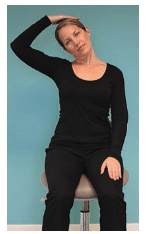
MSP can be caused by the overuse of tissues. As such, a consistent yoga practice may help to strengthen the tissues, as well as tone and nourish the muscles and joints. During yoga practice, the muscles are stretched through the lengthening of the muscle fibers, which increases flexibility and range of movement in the joints. Yoga is isometric stretching, which is holding a pose while contracting the muscles. The pressure applied to the bones during contraction will build muscle and may increase bone mass, thereby reducing the risk of osteoporosis. Some individuals may experience low back pain due to tight hamstrings. The hamstrings pull the pelvis in a way that affects the lumbar spine. Therefore, stretching the hamstrings may help reduce low back pain.19
In addition to regular yoga practice, minimizing the following awkward positions will help to reduce pain in the neck, shoulders, and hand/wrist areas: leaning forward or to one side; neck bending; bringing the shoulders too far forward; and reducing pinch force and repetitive motion when scaling. There are a number of ergonomic interventions for use in the dental practice that can also help dental hygienists reduce the risk of musculoskeletal injury (Table 1).
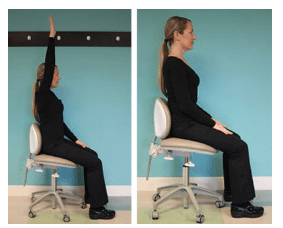
CHAIRSIDE YOGA STRETCHES
As the most frequently reported areas of pain among dental hygienists are the neck, shoulder, and back regions, it is important to strengthen the muscles in those areas. The following stretches can be practiced either chairside or at home. Side neck stretches (Figure 1) address the sternocleidomastoid and upper trapezius to reduce neck pain. Bring the right ear to the right shoulder, place the right hand on top of the head, and apply light pressure until a stretch is felt along the side of the neck. Hold this position for six breaths to eight breaths, and then repeat on the opposite side.
The seated alternate arm raise (Figure 2 and Figure 3) stretches the muscles of the upper and lower back and brings circulation to the neck and shoulders to reduce pain. Inhale and move the right arm toward the ceiling and pause; exhale as the right arm is brought back to neutral. Inhale and move the left arm toward the ceiling; pause. Exhale as the left arm is brought back to neutral. Repeat four times to six times.19

The chest expansion arm stretch (Figure 4) opens up the chest and stretches the pectoralis muscles while bringing the shoulders back into a neutral position. This pose counterbalances the forward “hunching” of the shoulders. Interlace the fingers behind the back while moving the shoulders away from the ears. Squeeze the shoulder blades together behind the back. Hold for eight breaths to 10 breaths and release.
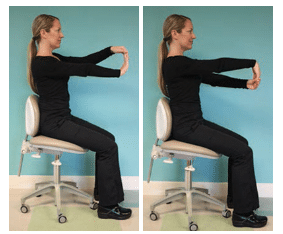
Wrist bending (Figure 5 and Figure 6) relieves pain in the wrist and improves range of motion. Extend the right arm to shoulder height and bring the fingers together. Bend the right hand at the wrist, pointing the fingers up, and place the left hand on the fingertips. Gently pull the right fingers, and hold for four breaths to six breaths. Next, bend the right hand at the wrist, fingers pointing to the floor, and place the left hand on the fingertips. Gently pull the right fingers, and hold for four breaths to six breaths. Repeat the same movements with the left arm.19
YOGA STRETCHES TO DO AT HOME
The triangle pose (Figure 7) relieves sciatica and back pain; strengthens the ankles, legs, and thighs; and stretches the hamstrings, shoulders, hips, chest, and spine. Separate the legs while turning the right foot forward at 90° and the left foot turned in slightly. Align the right heel with the left heel. The right kneecap should be over the right ankle. Extend the arms out to the side and inhale, lengthening through the sides of the torso. Then exhale and reach the right arm forward; move the left hip back; place the right hand onto the shin or ankle; and extend the left arm toward the ceiling while looking up at the left hand (look down at the right foot if this strains the neck). Engage the leg muscles and hold for four breaths to five breaths. Repeat on the opposite side.20
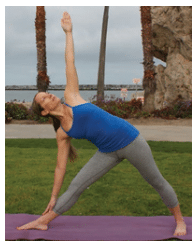
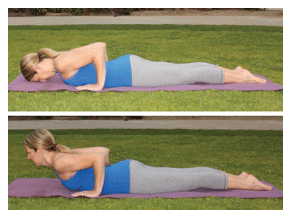
The low cobra (Figure 8 and Figure 9) relieves low back pain by strengthening the muscles and increasing flexibility in the lower back. It also strengthens the arms, chest, and shoulders. Lying flat on the stomach with the forehead on the mat, bring the hands next to the lower ribs while keeping the arms close to the body and the shoulders away from the ears. Separate the legs slightly, with the heels turned out. Inhale while lifting the head and chest off the mat and hold where it feels comfortable. Exhale as the chest and head are lowered back to the mat. Repeat six times to eight times.21
The bridge pose (Figure 10 and Figure 11) relieves back pain by stretching and strengthening the back muscles and improves circulation to the neck and shoulders. Lying flat on the back, bend the knees and separate the feet to hips distance with the toes pointing forward. Place the arms next to the hips and inhale, lifting the hips off the mat and toward the ceiling. Hold to where it feels comfortable, and exhale lowering the hips to the mat. Repeat six times to eight times.21

The hamstring stretch (Figure 12 and Figure 13) relieves back pain and sciatica by stretching the hamstrings. Lying on the back, bend the knees and separate the feet-to-hips distance with the toes pointing forward. Bring the right knee toward the chest, and interlace the fingers behind the right thigh. Inhale and extend the right leg toward the sky to where it feels comfortable and hold (avoid locking out the leg). Exhale, bringing the leg back to the bent position. Repeat the leg extensions three times to four times on the right leg, then repeat on the left.21

CONCLUSION
MSP negatively impacts all oral health professionals. Reinforcing the importance of ergonomic practice and learning how to properly stretch and strengthen the muscles may be helpful additions to dental hygiene curriculum. Dental hygienists need to incorporate strategies to prevent pain from occurring in order to increase career longevity, improve professional satisfaction, and enable them to be outstanding health care providers.
REFERENCES
- Hayes MJ, Smith DR, Taylor JA. Musculoskeletal disorders in a 3 year longitudinal cohort of dental hygiene students. J Dent Hyg. 2014;88(1): 36-41. Available at: adha.org. Registration required for access. Accessed May 8, 2015.
- Hayes MJ, Smith DR, Taylor JA. Musculoskeletal disorders and symptom severity among Australian dental hygienists. BMC Research Notes. 2013;6:250. Available at: biomedcentral.com/1756-0500/6/250.
- Hayes MJ, Taylor JA, Smith DR. Predictors of work-related musculoskeletal disorders among dental hygienists. Int J Dent Hygiene. 2012;10:265-269.
- Chismark A, Asher G, Stein M, Tavoc T, Curran A. Use of complementary and alternative medicine for work-related pain correlates with career satisfaction among dental hygienists. J Dent Hyg. 2011;85(4):273-284.
- Warren N. Causes of musculoskeletal disorders in dental hygienists and dental hygiene students: a study of combined biomechanical and psychosocial risk factors. Work. 2010;35: 441-454.
- Hayes MJ, Smith DR, Cockrell D. Prevalence and correlates of musculoskeletal disorders among Australian dental hygiene students. Int J Dent Hygiene. 2009;7:176-181.
- Morse T, Bruneau H, Michalak-Turcotte C et al. Musculoskeletal disorders of the neck and shoulder in dental hygienists and dental hygiene students. J Dent Hyg. 2007;81(1):e16.
- National Center for Complementary and Integrative Health. NCCIH facts-at-a-glance and mission. Available at: nccih.nih.gov/about/ataglance. Accessed May 8, 2015.
- National Center for Complementary and Integrative Health. Types of complementary health approaches. Available at: nccih.nih.gov/health/integrative-health#types. Accessed May 8, 2015.
- Cramer H, Lauche R, Hohmann C, Langhorst J, Dobos G. Yoga for chronic neck pain: a 12-month follow-up. Pain Medicine. 2013;14:541-548.
- Cramer H, et al. I’m more in balance: a qualitative study of yoga for patients with chronic neck pain. The Journal of Alternative and Complementary Medicine. 2013;19(6):536-542.
- Hartfiel N, Burton C, Rycroft-Malone J, Clarke G, Havenhand J, Khalsa SB, Edwards RT. Yoga for reducing perceived stress and back pain at work. Occupational Medicine. 2012. 62:606-612.
- Wattamwar RB, Nadkarni K. Effect of occupational therapy and yoga in chronic low back pain. The Indian Journal of Occupational Therapy. 2012;44(2):13-20.
- Saper RB, Boah AR, Keosaian J et al. Comparing once- versus twice-weekly yoga classes for chronic low back pain in predominantly low income minorities: a randomized dosing trial. Evidence-Based Complementary and Alternative Medicine. 2013:658030. Available at: hindawi.com/journals/ecam/2013/658030/. Accessed May 8, 2015.
- Sherman KJ, Cherkin DC, Wellman RD et al. A randomized trial comparing yoga, stretching, and a self-care book for chronic low back pain. Archives of Internal Medicine. 2011. Available at: archinte.jamanetwork.com/article.aspx?articleid=1106098. Accessed May 8, 2015.
- Tilbrook HE, Cox H, Hewitt CE et al. Yoga for chronic low back pain. Ann Intern Med. 2011; 155(9):569-578. Available at: annals.org/issue.aspx?journalid=90&issueID=20366&direction=P. Accessed May 8, 2015.
- Williams K, Abildso C, Steinberg L et al. Evaluation of the effectiveness and efficacy of Iyengar yoga therapy on chronic low back pain. Spine. 2009;34(19):2066-2076.
- Sarosky S, Stilp S, Akuthota V. Yoga and pilates in the management of low back pain. Curr Rev Musculoskeletal Med. 2008;1:39-47. Available at: link.springer.com/article/10.1007/s12178-007-9004-1/fulltext.html. Accessed May 8, 2015.
- Payne L, Usatine R. Yoga Rx: a step-by-step program to promote health, wellness, and healings for common ailments. In: The Musculoskeletal System: Back, Knees, Arthritis. 1st ed. New York, NY: Broadway Books;2002:102-148.
- Yoga Journal. Extended Triangle Pose. Available at: yogajournal.com/pose/extended-triangle-pose/. Accessed May 8, 2015.
From Dimensions of Dental Hygiene. November 2015;13(11):30,32,34.


